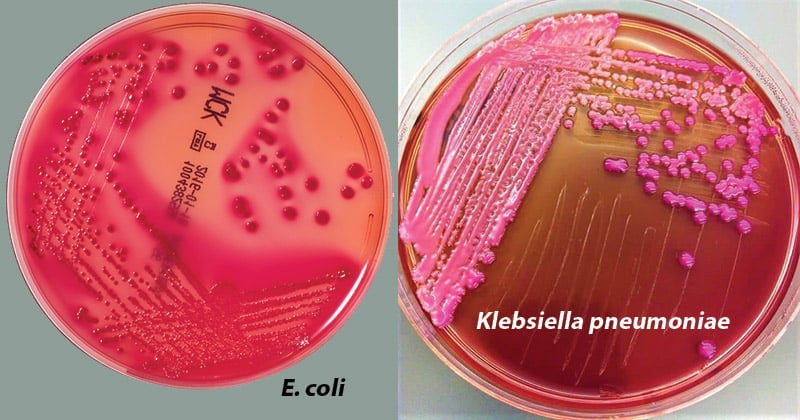MacConkey agar was the first solid differential media to be formulated which was developed in the 20th century by Alfred Theodore MacConkey. MacConkey Agar is the earliest selective and differential medium for the cultivation of coliform organisms. It is used for the isolation and differentiation of non-fastidious gram-negative rods, particularly members of the family Enterobacteriaceae and the genus Pseudomonas.
Interesting Science Videos
Composition of MacConkey Agar
| Ingredients | Amount |
| Peptone (Pancreatic digest of gelatin) | 17 gm |
| Proteose peptone (meat and casein) | 3 gm |
| Lactose monohydrate | 10 gm |
| Bile salts | 1.5 gm |
| Sodium chloride | 5 gm |
| Neutral red | 0.03 gm |
| Crystal Violet | 0.001 gm |
| Agar | 13.5 gm |
Principle of MacConkey Agar
Pancreatic digest of gelatin and peptones (meat and casein) provide the essential nutrients, vitamins, and nitrogenous factors required for the growth of microorganisms. Lactose monohydrate is the fermentable source of carbohydrates. The selective action of this medium is attributed to crystal violet and bile salts, which are inhibitory to most species of gram-positive bacteria. Sodium chloride maintains the osmotic balance in the medium.
Lactose fermenting strains grow red or pink. The red color is due to the production of acid from lactose, absorption of neutral red, and a subsequent color change of the dye when the pH of the medium falls below 6.8. Non-lactose fermenting bacteria such as Salmonella, Proteus, Pseudomonas aeruginosa, and Shigella cannot utilize lactose and will use peptone instead. This forms ammonia, which raises the pH of the agar, and leads to the formation of white or colorless colonies formed in the plate and the agar surrounding the bacteria remains relatively transparent. These colonies can also look golden to brown with dark centers.
Lactose can be replaced in the medium by other sugars and the replacement sugars can be used to test the abilities of gram-negative bacteria to ferment the replacement sugars. For example, sorbitol can be used as a replacement sugar in MacConkey agar to assist in the isolation and differentiation of enteropathogenic E. coli serotypes such as E. coli O157:H7 by the presence of white circular colonies that are non-sorbitol fermenting.
Preparation of MacConkey Agar
- Suspend 49.53 grams of dehydrated medium in 1000 ml of distilled water.
- Heat to boiling to dissolve the medium completely.
- Sterilize by autoclaving at 15 lbs pressure (121°C) for 15 minutes.
- Cool to 45°C -50°C.
- Mix well before pouring into sterile Petri plates.
Result Interpretation on MacConkey Agar

| Organisms | Growth results |
| Escherichia coli | Pink to rose-red colonies (may be surrounded by a zone of precipitated bile) |
| Enterobacter, Klebsiella | Mucoid, pink colonies |
| Proteus | Colorless colonies, swarming growth |
| Salmonella, Shigella | Colorless colonies, or sometimes medium color: orange to amber |
| Pseudomonas | Irregular, colorless to pink colonies |
Uses of MacConkey Agar
- MacConkey agar is used for the isolation of gram-negative enteric bacteria.
- It is used in the differentiation of lactose fermenting from lactose non-fermenting gram-negative bacteria.
- It is use in microbiological examination of food stuffs and for direct plating / inoculation of water samples for coliform counts.
- It is used for the examination of milk and dairy products.
- British pharmacopoeia has recommended this medium for the subculture and identification of Escherichia coli.
Limitations of MacConkey Agar
- The colonial characteristics describe give presumptive identification only of the isolated organisms. It is necessary to subculture and carryout other confirmation tests like biochemical tests for final identification.
- Some strains may be encountered that grow poorly or fail to grow on this medium.
- Incubation of MacConkey Agar plates under increased CO2 has been reported to reduce growth and recovery of a number of strains of Gram-negative bacilli.
- Some strains of Proteus may swarm on this medium.
References
- https://catalog.hardydiagnostics.com/cp_prod/Content/hugo/MacConkeyAgar.htm
- http://www.himedialabs.com/TD/M081B.pdf
- http://www.himedialabs.com/TD/M008S.pdf
- https://www.teknova.com/category-s/504.htm
- http://www.bd.com/resource.aspx?IDX=8978
- https://microbeonline.com/macconkey-agar-mac-composition-preparation-uses-and-colony-characteristics/

What is the best medium for blood culture in a medium size laboratory. Manual method?
Great work.
How enterobactericea count done on macckonkey agar? Interms of colony selection and or types of colony to be counted??
Thank you, very useful for food labs, guides in decision making before conducting confirmatory tests.
It is helpful. But what if the MacConkey agar has black colonies?
I have the same scenario I have a black colony on McConkey agar
A black colony on MacConkey agar typically indicates the presence of a Gram-negative bacterium that is capable of fermenting lactose and producing hydrogen sulfide (H2S). One common example is Salmonella spp., which can produce black colonies on MacConkey agar due to its ability to reduce sulfur compounds in the medium, leading to the formation of black precipitates.
Very helpful
I find this content so helpful. thank you!